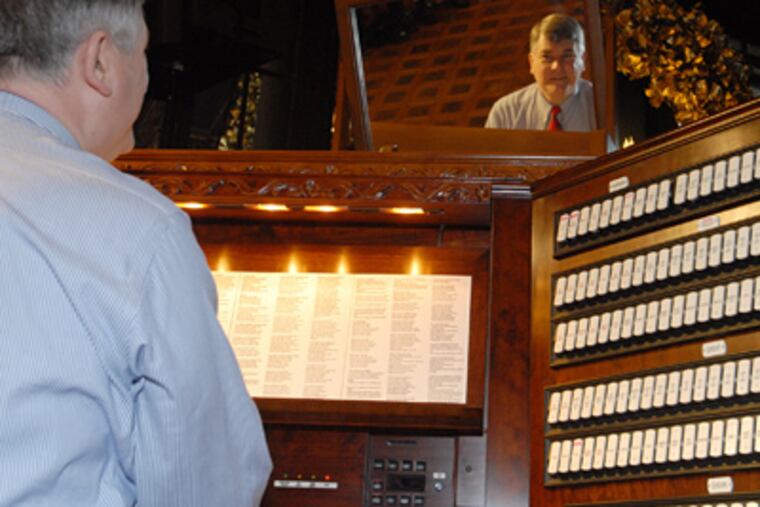Caroling to Longwood organ helps ward off the chill
It was nowhere near a white Christmas, just rainy, and those weren't bells jingling, just key rings and change purses.

It was nowhere near a white Christmas, just rainy, and those weren't bells jingling, just key rings and change purses.
But yesterday's Christmas carol sing-along and organ concert at Longwood Gardens in Kennett Square was a welcome antidote to a gray day and a grim year. "Puts me in the spirit," said Teresa Souders of West Chester, among the more animated of the 133 concertgoers in the famous ballroom, a chandeliered affair built by Longwood founder Pierre S. du Pont in 1929 to house his 55-ton pipe organ.
Arms around one another, Souders and her friends sang "Let It Snow" and "Jingle Bells" in robust fashion to the accompaniment of Marc F. Cheban, one of four Longwood organists.
Cheban, music director at St. Thomas Episcopal Church in Newark, Del., who's been performing organ recitals at Longwood since 1981, was decked out in red Christmas tie and socks and his special organist shoes. They're black leather, narrow and thin-soled, like a dancer's shoes, made for quick, deft footwork on the pedals.
Speaking of pedals and movements, the Longwood organ - nearing the end of an $8.4 million restoration - is a gorgeous whopper with 10,010 pipes, enough to fill five "rooms," or divisions, that are manipulated by the organist to control volume. The actual organ as we know it - the console - is in the ballroom; the considerable innards are off to the side in a museumlike exhibit.
Longwood's is a "residence organ," made by the aeolian Co. of New York, and you'd better believe you needed a residence bigger than a rowhouse to accommodate it. Check out the customer list: Carnegie, Ford, Mellon, Rockefeller, Tiffany, Vanderbilt, and du Pont, who owned the largest and most expensive one the company ever made.
Cheban played down the difficulty of mastering such a behemoth, whose tallest pipe measures 37 feet, one yard square.
"All organs are constructed along similar lines, so if an organ is really a lot bigger than another one, it may not be that much more complicated. It's just more of the stuff you'd have on another organ," he said.
Still, Cheban calls the Longwood organ "a thrilling instrument. One moment it can just thunder and shake you all over and the next moment it can whisper so gently it moves you to tears. And you have every gradation between those two extremes," he said.
Yesterday, all of the above was in play.
Feet flying like Gene Kelly down below, fingers doing the same up above, Cheban was a veritable Upstairs, Downstairs one-man band. His instrument was capable of producing military flourishes, sleigh bells, swells and strings, percussion instruments and drums, base notes that literally shook the building. One set of 32-foot pipes - the Contra Bombarde - sounds like a giant bullfrog.
There were no bullfrogs yesterday, but the half-hour program warmed and amused the crowd. David and Kelly Griffith of Wilmington and their daughters Emma, 7, and Caroline, 9, clearly had a ball. "It was festive and fun," David Griffith said. "The whole family can do it together."
Historically, the ballroom - measuring 101 feet by 30 feet, with fabric-covered walls - has been used for concerts, lectures, dinners, and galas. It's an elegant space that spills out into the exhibition hall, dominated at this time of year by a huge Christmas tree and 85-foot carpet of red begonias, white poinsettias, green moss, and gold pine cones.
Du Pont delighted in the performing arts, and in a 1927 letter confessed that he loved all kinds of music "except jazz, which my ear does not distinguish from noise."
Organ music was his favorite, and the current organ, Longwood's second, cost him $123,000 eight decades ago. Before his death in 1954, he hosted about 1,500 organ concerts, frequently - like yesterday - on Sunday afternoons.
Guests might include the Boy Scouts or du Pont's pals in the Guernsey Breeders Association. For friends and family, he threw debutante balls, birthday parties, and intimate dinners.
There might be a Widener or Elkins on the A list, a Mellon, Sloan, or Kettering, with a catered meal we'd consider fancy today. Yet compared with the extravagant opulence of his gilded peers' festivities, du Pont's were quite modest, according to Longwood historian Colvin Randall.
For an organ concert in the 1920s given by the French virtuoso Marcel Dupré, du Pont and his wife served 287 guests bouillon and sandwiches, small cakes and candies, nuts, coffee and tea, cigars and cigarettes.
Dinner might be just two or three courses, Randall said, "not like one of these banquets you hear about at the New York Waldorf Astoria where 'Mrs. Astor's 400' are sitting around."
Du Pont, who lived in the relatively modest Longwood manse now known as the Pierce-du Pont House, "was far too practical to be excessive like that," Randall said.
When giving classical recitals at Longwood, Cheban has keenly sensed this history. "You almost felt like genuflecting before you sat down at the console," he said. "It's a little harder to have that context when you have 'Jingle Bells' and 'Rudolph, the Red-Nosed Reindeer.' "
But the carols spark happy memories, and people in the audience sometimes cry and thank Cheban for making their day. Yesterday, they lined up to buy his CD.
"What happens in that ballroom for that brief half-hour is the humanity of everyone gets mingled together, enhanced and glorified," Cheban said. "If 'Jingle Bells' is the way to do that, then that's the way to do it."